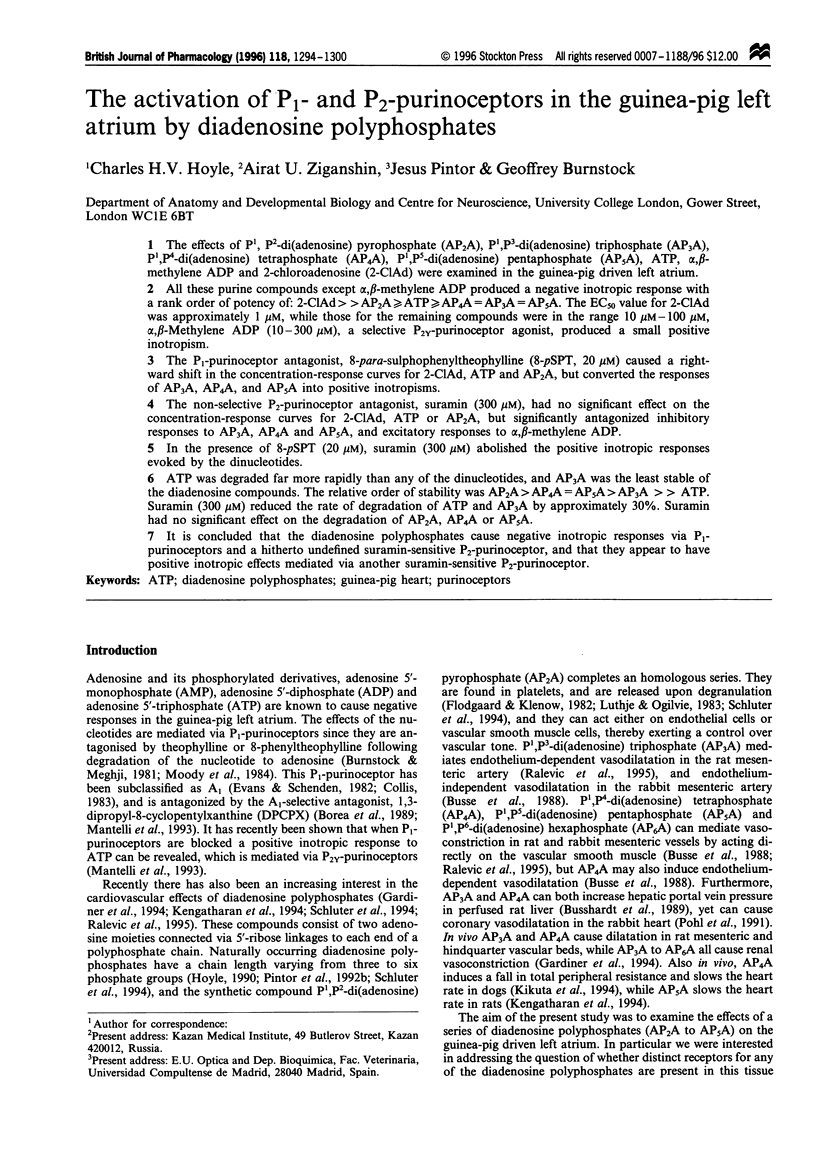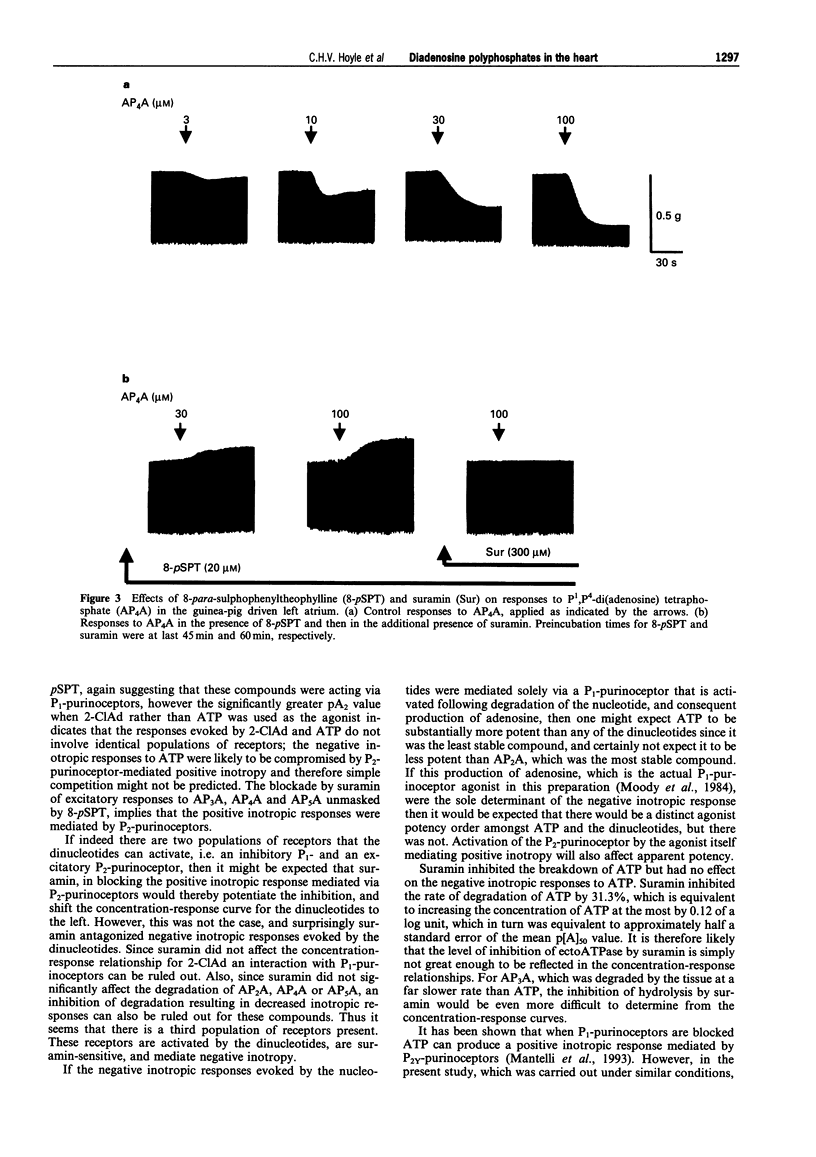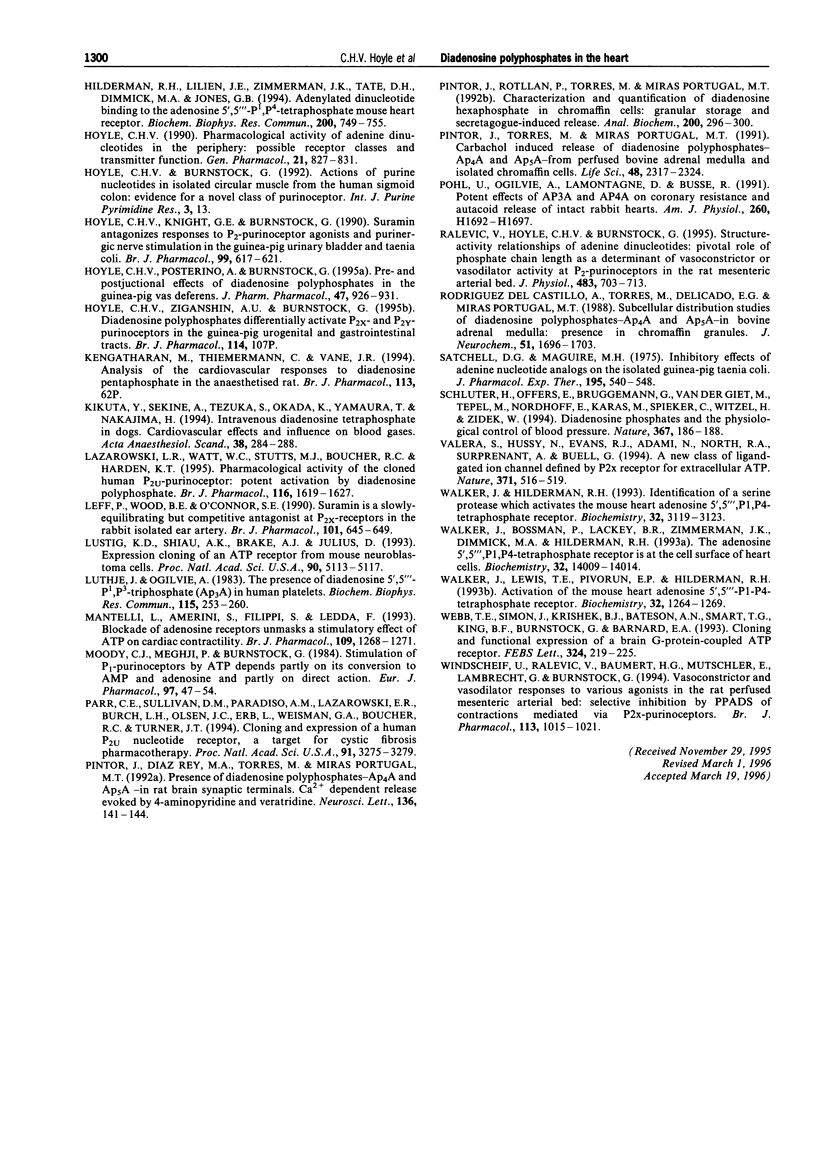Abstract
1. The effects of P1, P2-di(adenosine) pyrophosphate (AP2A), P1, P3-di(adenosine) triphosphate (AP3A), P1,P4-di(adenosine) tetraphosphate (AP4A), P1,P5-di(adenosine) pentaphosphate (AP5A), ATP, alpha, beta-methylene ADP and 2-chloroadenosine (2-ClAd) were examined in the guinea-pig driven left atrium. 2. All these purine compounds except alpha, beta-methylene ADP produced a negative inotropic response with a rank order of potency of: 2-ClAd > > AP2A > or = ATP > or = AP4A = AP3A = AP5A. The EC50 value for 2-ClAd was approximately 1 microM, while those for the remaining compounds were in the range 10 microM-100 microM, alpha, beta-Methylene ADP (10-300 microM), a selective P2Y-purinoceptor agonist, produced a small positive inotropism. 3. The P1-purinoceptor antagonist, 8-para-sulphophenyltheophylline (8-pSPT, 20 microM) caused a right-ward shift in the concentration-response curves for 2-ClAd, ATP and AP2A, but converted the responses of AP3A, AP4A, and AP5A into positive inotropisms. 4. The non-selective P2-purinoceptor antagonist, suramin (300 microM), had no significant effect on the concentration-response curves for 2-ClAd, ATP or AP2A, but significantly antagonized inhibitory responses to AP3A, AP4A and AP5A, and excitatory responses to alpha, beta-methylene ADP. 5. In the presence of 8-pSPT (20 microM), suramin (300 microM) abolished the positive inotropic responses evoked by the dinucleotides. 6. ATP was degraded far more rapidly than any of the dinucleotides, and AP3A was the least stable of the diadenosine compounds. The relative order of stability was AP2A > AP4A = AP5A > AP3A > > ATP. Suramin (300 microM) reduced the rate of degradation of ATP and AP3A by approximately 30%. Suramin had no significant effect on the degradation of AP2A, AP4A or AP5A. 7. It is concluded that the diadenosine polyphosphates cause negative inotropic responses via P1-purinoceptors and a hitherto undefined suramin-sensitive P2-purinoceptor, and that they appear to have positive inotropic effects mediated via another suramin-sensitive P2-purinoceptor.
Full text
PDF






Selected References
These references are in PubMed. This may not be the complete list of references from this article.
- Borea P. A., Caparrotta L., De Biasi M., Fassina G., Froldi G., Pandolfo L., Ragazzi E. Effect of selective agonists and antagonists on atrial adenosine receptors and their interaction with Bay K 8644 and [3H]-nitrendipine. Br J Pharmacol. 1989 Feb;96(2):372–378. doi: 10.1111/j.1476-5381.1989.tb11827.x. [DOI] [PMC free article] [PubMed] [Google Scholar]
- Burnstock G., Meghji P. Distribution of P1- and P2-purinoceptors in the guinea-pig and frog heart. Br J Pharmacol. 1981 Aug;73(4):879–885. doi: 10.1111/j.1476-5381.1981.tb08741.x. [DOI] [PMC free article] [PubMed] [Google Scholar]
- Busse R., Ogilvie A., Pohl U. Vasomotor activity of diadenosine triphosphate and diadenosine tetraphosphate in isolated arteries. Am J Physiol. 1988 May;254(5 Pt 2):H828–H832. doi: 10.1152/ajpheart.1988.254.5.H828. [DOI] [PubMed] [Google Scholar]
- Busshardt E., Gerok W., Häussinger D. Regulation of hepatic parenchymal and non-parenchymal cell function by the diadenine nucleotides Ap3A and Ap4A. Biochim Biophys Acta. 1989 Feb 9;1010(2):151–159. doi: 10.1016/0167-4889(89)90155-9. [DOI] [PubMed] [Google Scholar]
- Collis M. G. Evidence for an A1-adenosine receptor in the guinea-pig atrium. Br J Pharmacol. 1983 Jan;78(1):207–212. doi: 10.1111/j.1476-5381.1983.tb09381.x. [DOI] [PMC free article] [PubMed] [Google Scholar]
- Evans D. B., Schenden J. A., Bristol J. A. Adenosine receptors mediating cardiac depression. Life Sci. 1982 Nov 29;31(22):2425–2432. doi: 10.1016/0024-3205(82)90746-9. [DOI] [PubMed] [Google Scholar]
- Fedan J. S., Hogaboom G. K., Westfall D. P., O'Donnell J. P. Comparison of contractions of the smooth muscle of the guinea-pig vas deferens induced by ATP and related nucleotides. Eur J Pharmacol. 1982 Jul 9;81(2):193–204. doi: 10.1016/0014-2999(82)90437-x. [DOI] [PubMed] [Google Scholar]
- Flodgaard H., Klenow H. Abundant amounts of diadenosine 5',5"'-P1,P4-tetraphosphate are present and releasable, but metabolically inactive, in human platelets. Biochem J. 1982 Dec 15;208(3):737–742. doi: 10.1042/bj2080737. [DOI] [PMC free article] [PubMed] [Google Scholar]
- Fredholm B. B., Sandberg G. Inhibition by xanthine derivatives of adenosine receptor-stimulated cyclic adenosine 3',5'-monophosphate accumulation in rat and guinea-pig thymocytes. Br J Pharmacol. 1983 Dec;80(4):639–644. doi: 10.1111/j.1476-5381.1983.tb10053.x. [DOI] [PMC free article] [PubMed] [Google Scholar]
- Hilderman R. H., Lilien J. E., Zimmerman J. K., Tate D. H., Dimmick M. A., Jones G. B. Adenylated dinucleotide binding to the adenosine 5',5'''-P1,P4-tetraphosphate mouse heart receptor. Biochem Biophys Res Commun. 1994 Apr 29;200(2):749–755. doi: 10.1006/bbrc.1994.1514. [DOI] [PubMed] [Google Scholar]
- Hoyle C. H., Knight G. E., Burnstock G. Suramin antagonizes responses to P2-purinoceptor agonists and purinergic nerve stimulation in the guinea-pig urinary bladder and taenia coli. Br J Pharmacol. 1990 Mar;99(3):617–621. doi: 10.1111/j.1476-5381.1990.tb12979.x. [DOI] [PMC free article] [PubMed] [Google Scholar]
- Hoyle C. H. Pharmacological activity of adenine dinucleotides in the periphery: possible receptor classes and transmitter function. Gen Pharmacol. 1990;21(6):827–831. doi: 10.1016/0306-3623(90)90440-w. [DOI] [PubMed] [Google Scholar]
- Kikuta Y., Sekine A., Tezuka S., Okada K., Yamaura T., Nakajima H. Intravenous diadenosine tetraphosphate in dogs. Cardiovascular effects and influence on blood gases. Acta Anaesthesiol Scand. 1994 Apr;38(3):284–288. doi: 10.1111/j.1399-6576.1994.tb03890.x. [DOI] [PubMed] [Google Scholar]
- Lazarowski E. R., Watt W. C., Stutts M. J., Boucher R. C., Harden T. K. Pharmacological selectivity of the cloned human P2U-purinoceptor: potent activation by diadenosine tetraphosphate. Br J Pharmacol. 1995 Sep;116(1):1619–1627. doi: 10.1111/j.1476-5381.1995.tb16382.x. [DOI] [PMC free article] [PubMed] [Google Scholar]
- Leff P., Wood B. E., O'Connor S. E. Suramin is a slowly-equilibrating but competitive antagonist at P2x-receptors in the rabbit isolated ear artery. Br J Pharmacol. 1990 Nov;101(3):645–649. doi: 10.1111/j.1476-5381.1990.tb14134.x. [DOI] [PMC free article] [PubMed] [Google Scholar]
- Lustig K. D., Shiau A. K., Brake A. J., Julius D. Expression cloning of an ATP receptor from mouse neuroblastoma cells. Proc Natl Acad Sci U S A. 1993 Jun 1;90(11):5113–5117. doi: 10.1073/pnas.90.11.5113. [DOI] [PMC free article] [PubMed] [Google Scholar]
- Lüthje J., Ogilvie A. The presence of diadenosine 5',5'''-P1,P3-triphosphate (Ap3A) in human platelets. Biochem Biophys Res Commun. 1983 Aug 30;115(1):253–260. doi: 10.1016/0006-291x(83)90997-x. [DOI] [PubMed] [Google Scholar]
- Mantelli L., Amerini S., Filippi S., Ledda F. Blockade of adenosine receptors unmasks a stimulatory effect of ATP on cardiac contractility. Br J Pharmacol. 1993 Aug;109(4):1268–1271. doi: 10.1111/j.1476-5381.1993.tb13759.x. [DOI] [PMC free article] [PubMed] [Google Scholar]
- Moody C. J., Meghji P., Burnstock G. Stimulation of P1-purinoceptors by ATP depends partly on its conversion to AMP and adenosine and partly on direct action. Eur J Pharmacol. 1984 Jan 13;97(1-2):47–54. doi: 10.1016/0014-2999(84)90511-9. [DOI] [PubMed] [Google Scholar]
- Parr C. E., Sullivan D. M., Paradiso A. M., Lazarowski E. R., Burch L. H., Olsen J. C., Erb L., Weisman G. A., Boucher R. C., Turner J. T. Cloning and expression of a human P2U nucleotide receptor, a target for cystic fibrosis pharmacotherapy. Proc Natl Acad Sci U S A. 1994 Apr 12;91(8):3275–3279. doi: 10.1073/pnas.91.8.3275. [DOI] [PMC free article] [PubMed] [Google Scholar]
- Pintor J., Díaz-Rey M. A., Torres M., Miras-Portugal M. T. Presence of diadenosine polyphosphates--Ap4A and Ap5A--in rat brain synaptic terminals. Ca2+ dependent release evoked by 4-aminopyridine and veratridine. Neurosci Lett. 1992 Mar 2;136(2):141–144. doi: 10.1016/0304-3940(92)90034-5. [DOI] [PubMed] [Google Scholar]
- Pintor J., Rotllán P., Torres M., Miras-Portugal M. T. Characterization and quantification of diadenosine hexaphosphate in chromaffin cells: granular storage and secretagogue-induced release. Anal Biochem. 1992 Feb 1;200(2):296–300. doi: 10.1016/0003-2697(92)90469-n. [DOI] [PubMed] [Google Scholar]
- Pintor J., Torres M., Miras-Portugal M. T. Carbachol induced release of diadenosine polyphosphates--Ap4A and Ap5A--from perfused bovine adrenal medulla and isolated chromaffin cells. Life Sci. 1991;48(24):2317–2324. doi: 10.1016/0024-3205(91)90268-g. [DOI] [PubMed] [Google Scholar]
- Pohl U., Ogilvie A., Lamontagne D., Busse R. Potent effects of AP3A and AP4A on coronary resistance and autacoid release of intact rabbit hearts. Am J Physiol. 1991 May;260(5 Pt 2):H1692–H1697. doi: 10.1152/ajpheart.1991.260.5.H1692. [DOI] [PubMed] [Google Scholar]
- Ralevic V., Hoyle C. H., Burnstock G. Pivotal role of phosphate chain length in vasoconstrictor versus vasodilator actions of adenine dinucleotides in rat mesenteric arteries. J Physiol. 1995 Mar 15;483(Pt 3):703–713. doi: 10.1113/jphysiol.1995.sp020615. [DOI] [PMC free article] [PubMed] [Google Scholar]
- Rodriguez del Castillo A., Torres M., Delicado E. G., Miras-Portugal M. T. Subcellular distribution studies of diadenosine polyphosphates--Ap4A and Ap5A--in bovine adrenal medulla: presence in chromaffin granules. J Neurochem. 1988 Dec;51(6):1696–1703. doi: 10.1111/j.1471-4159.1988.tb01147.x. [DOI] [PubMed] [Google Scholar]
- Satchell D. G., Maguire M. H. Inhibitory effects of adenine nucleotide analogs on the isolated guinea-pig taenia coli. J Pharmacol Exp Ther. 1975 Dec;195(3):540–548. [PubMed] [Google Scholar]
- Schlüter H., Offers E., Brüggemann G., van der Giet M., Tepel M., Nordhoff E., Karas M., Spieker C., Witzel H., Zidek W. Diadenosine phosphates and the physiological control of blood pressure. Nature. 1994 Jan 13;367(6459):186–188. doi: 10.1038/367186a0. [DOI] [PubMed] [Google Scholar]
- Valera S., Hussy N., Evans R. J., Adami N., North R. A., Surprenant A., Buell G. A new class of ligand-gated ion channel defined by P2x receptor for extracellular ATP. Nature. 1994 Oct 6;371(6497):516–519. doi: 10.1038/371516a0. [DOI] [PubMed] [Google Scholar]
- Walker J., Bossman P., Lackey B. R., Zimmerman J. K., Dimmick M. A., Hilderman R. H. The adenosine 5',5"',P1,P4-tetraphosphate receptor is at the cell surface of heart cells. Biochemistry. 1993 Dec 21;32(50):14009–14014. doi: 10.1021/bi00213a034. [DOI] [PubMed] [Google Scholar]
- Walker J., Hilderman R. H. Identification of a serine protease which activates the mouse heart adenosine 5',5"',P1,P4-tetraphosphate receptor. Biochemistry. 1993 Mar 30;32(12):3119–3123. doi: 10.1021/bi00063a025. [DOI] [PubMed] [Google Scholar]
- Walker J., Lewis T. E., Pivorun E. P., Hilderman R. H. Activation of the mouse heart adenosine 5',5"'-P1-P4-tetraphosphate receptor. Biochemistry. 1993 Feb 9;32(5):1264–1269. doi: 10.1021/bi00056a010. [DOI] [PubMed] [Google Scholar]
- Webb T. E., Simon J., Krishek B. J., Bateson A. N., Smart T. G., King B. F., Burnstock G., Barnard E. A. Cloning and functional expression of a brain G-protein-coupled ATP receptor. FEBS Lett. 1993 Jun 14;324(2):219–225. doi: 10.1016/0014-5793(93)81397-i. [DOI] [PubMed] [Google Scholar]
- Windscheif U., Ralevic V., Bäumert H. G., Mutschler E., Lambrecht G., Burnstock G. Vasoconstrictor and vasodilator responses to various agonists in the rat perfused mesenteric arterial bed: selective inhibition by PPADS of contractions mediated via P2x-purinoceptors. Br J Pharmacol. 1994 Nov;113(3):1015–1021. doi: 10.1111/j.1476-5381.1994.tb17094.x. [DOI] [PMC free article] [PubMed] [Google Scholar]


